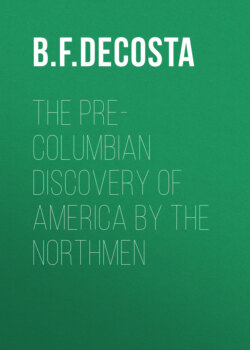Читать книгу The Pre-Columbian Discovery of America by the Northmen - B. F. DeCosta - Страница 16
MONUMENTS AND RUINS.
ОглавлениеTheir villages and farms were numerous. Together they probably numbered several hundred, the ruins now left being both abundant and extensive. Near Igaliko, which is supposed to be the same as the ancient Einarsfiord, are the ruins of a church, probably the cathedral of Gardar. It is called the Kakortok church. It was of simple but massive architecture, and the material was taken from the neighboring cliffs. The stone is rough hewn, and but few signs of mortar are visible. It is fifty-one feet long and twenty-five wide. The north and south walls are over four feet thick, while the end walls are still more massive.
Nor are other monuments wanting. At Igalikko, nine miles from Julian's Hope, a Greenlander being one day employed in obtaining stones to repair his house, found among a pile of fragments a smooth stone that bore, what seemed to him, written characters. He mentioned the circumstance to Mr. Mathieson, the colonial director at Julian's Hope, who inferred that it must be a runic stone. He was so fortunate as to find it afterwards, and he accordingly sent it to Copenhagen, where it arrived in the year 1830. The runes, which were perfectly distinct, showed that it was a tombstone. The inscription was translated as follows:
"Vigdis Mars Daughter Rests Here.
May God Gladden Her Soul."
Another found in 1831, by the Rev. Mr. De Fries, principal of the Moravian Mission, bore the following inscription in the runic letter:
"Here Rests Hroar Kolgrimsson."
This stone, now in the museum at Copenhagen, was found built into the wall over the entrance of a Greenland house, having been taken for that purpose from a heap of ruins, about two miles north of Friederichsthal. This stone is more than three feet long, being eighteen inches wide in the narrowest part, and about five inches thick. It bears every sign of a high antiquity.
But one of the most interesting remains which prove the Icelandic occupation of Greenland is the runic stone found by Parry, in 1824, in the island of Kingiktorsoak, lying in 72° 55´ N. and 56° 51´ W. It contained a somewhat lengthy inscription, and copies of it were sent to three of the first scholars of the age, Finn Magnusson, Professor Rask, and Dr. Bryniulfson, who, without consultation, at once arrived at the same conclusion and united in giving the following translation:
"Erling Sighvatson and Biorn Thordarson and
Eindrid Oddson, on Saturday before
Ascension week, raised these
marks and cleared
ground. 1135."[37]
The Icelandic colonists in Greenland do not appear to have been confined to a small portion of territory. We find considerable relating to this subject in the chronicle attributed to Ivar Bert,[38] the steward of one of the bishops of Greenland; yet, though used extensively by Torfæus, modern researches in this country prove that it is in some respects faulty. In this chronicle, as in the Sagas, the colonists are spoken of as possessing horses, sheep and oxen; and their churches and religious houses appear to have been well supported.
